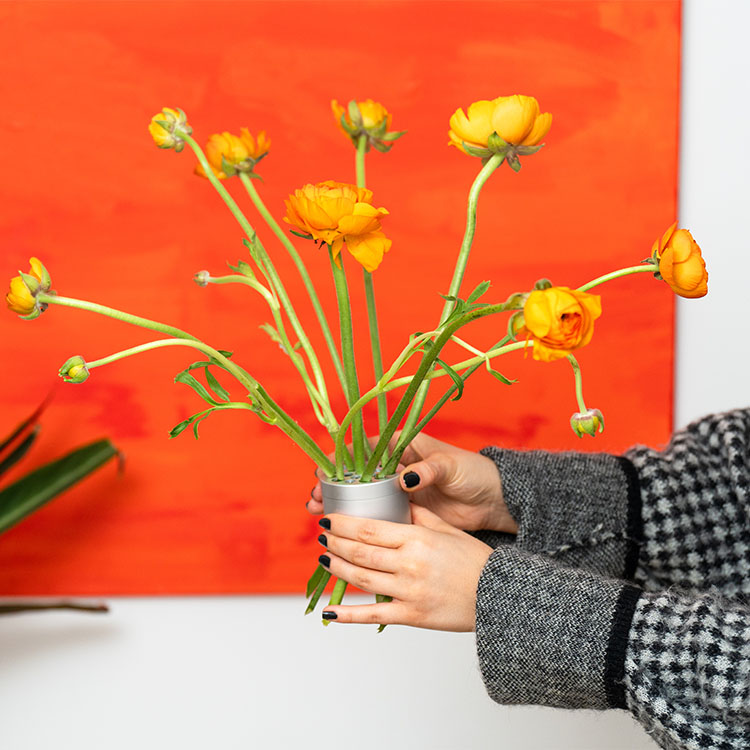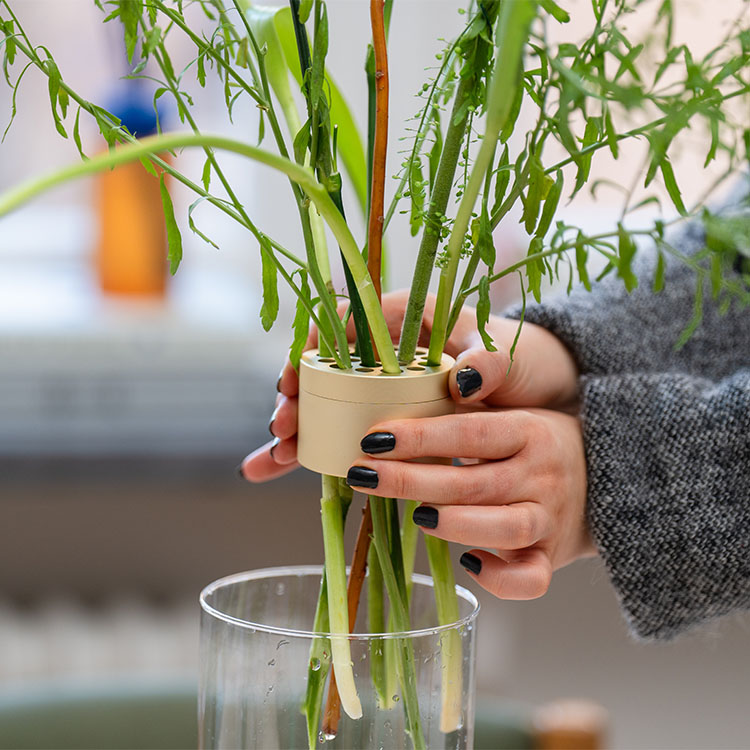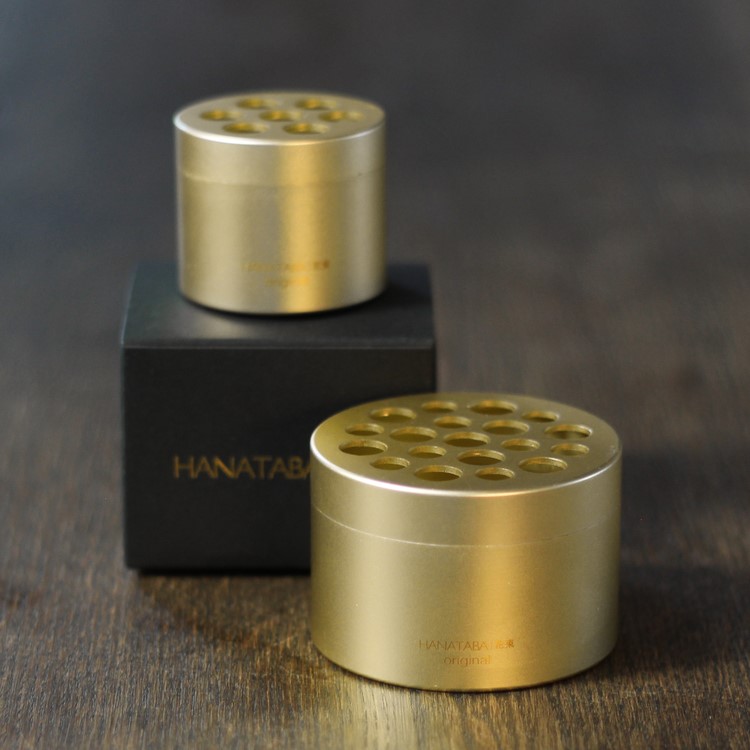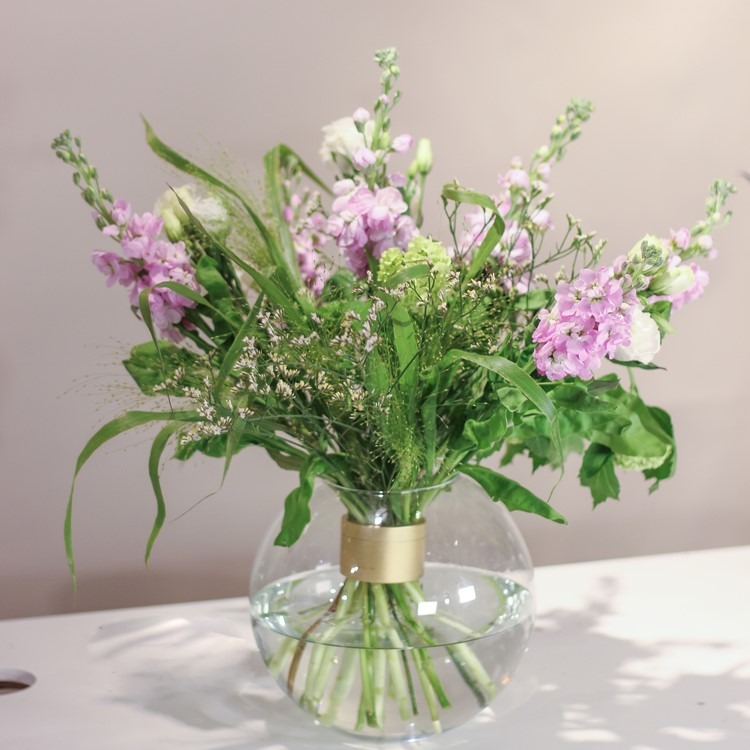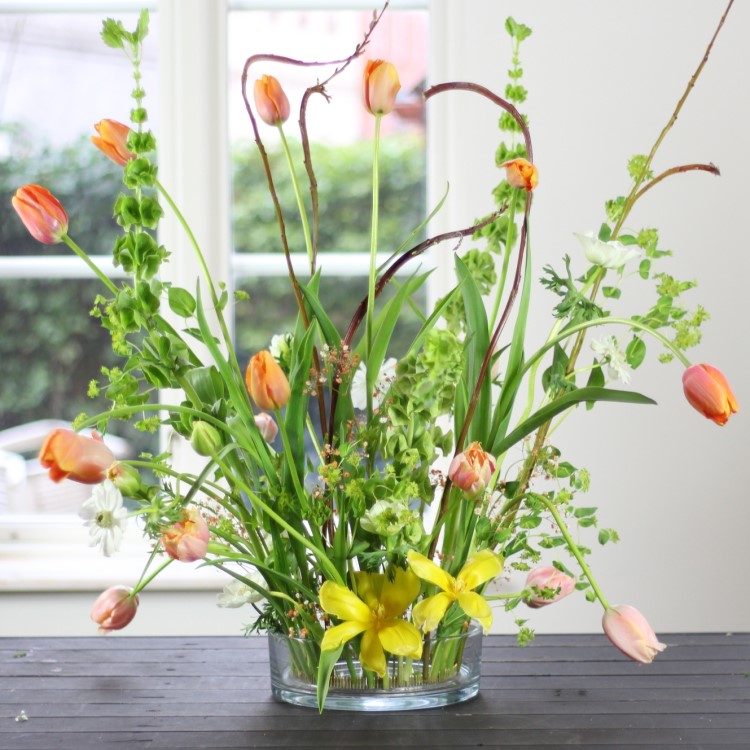A flourishing innovation
"It takes a while to crack the code. And as I sat there and watched the students, my brain started working."
It was this balancing act that got Christian thinking about what actually constitutes a flower bouquet and whether it would be possible to simplify the binding itself. He envisioned two discs with holes in them to guide and hold the stems in the desired formation. But how would the discs be removed without the bouquet losing its shape? Perhaps ice discs that melt away would work, or nutrient discs that dissolve on contact with water. But none of the ideas were particularly convincing. The vision was there, but it was not crystal clear. And it would take almost two full decades for it to take shape.
An idea takes root
Then one day the pieces fell into place - a summer day when the sun was shining as it only does in the countryside in the south of Sweden, and the neighbour, an engineer, somehow became the unexpected piece of the puzzle that put everything in place. The neighbour was keen to dive into something new and challenging, so he casually asked if Christian had something for him to figure out. Of course, Christian had just the right riddle for the occasion, and told him about the idea he had been working on for almost 20 years. With a snuff box in hand, Christian illustrated how the flower stalks could be inserted into the holder and by turning the parts of the box against each other, the bouquet would form itself. And it was just as he was sketching out the function that the moment of clarity occurred. The discs, which he had previously seen as a makeshift support, were at the heart of the whole design. They would neither melt nor dissolve; they would become part of the bouquet.
Despite Christian's efforts to have his idea manufactured at home, there was no response from Swedish manufacturing companies. Out of ten enquiries, not a single one came back with an answer. It was only when he turned to the global market via the Alibaba marketplace that things started to move. There, the exchange of design sketches and ideas immediately took off, and soon he had his first real prototype - close to the desired size, but with a boxier shape.
"Adapting the design to the diversity of flowers was always a challenge. With flowers varying so enormously in stem thickness, the holes needed to be adapted to easily pinch stems of different sizes. That's why the Hanataba consists of ten larger holes and nine smaller ones, with an expandable silicone disc underneath to accommodate thinner stems and extra greenery."
As the prototype took shape, Christian searched for similar products, convinced that someone must have thought of the same idea before. But to his surprise, he found nothing similar. The Hanataba is the first of its kind - completely unique in the way it twists and ties bouquets - and the question of a patent came up. The costs were daunting, especially given the uncertainty of demand. Design patents and trade mark protection were cheaper options, but did not offer global protection. And Christian was well aware of the dual reality of the world of innovation - where success is often followed by imitation. But he was not deterred. He knew that a strong brand could provide the edge needed when successors begin to emerge.
From seed to bud to blossoming success
Hanataba's idea first landed in an industry known for its roots. The floral industry is very traditional, and when Hanataba was shown to colleagues and industry experts, the reaction was lukewarm. Why would a florist need one of these? And if it wasn't meant for florists, would it replace the florist?But this scepticism was not enough to stop Hanataba's progress, and despite a modest six square metres of stand space, its Formex debut was an instant success. Before the fair, Christian published a product film in a Facebook group for florists around Sweden. And it didn't take more than five minutes before they got the first sign of life - Karl Fredrik from Österlen, a popular profile in the flower world, immediately saw the potential and offered to become one of the brand's first retailers and ambassadors. Thanks to the spread of the product film, visitors soon flocked to the stand, and Hanataba managed to secure around 70 retailers. And from there, things have taken off, with expansion from Sweden to our Nordic neighbours, Europe, and from there to the rest of the world. And that in just a few years. Today, the US is the largest market and Hanataba continues to break new ground with partnerships in Asia.
Christian and Jenny's journey demonstrates the adventure that comes from daring, and from braving the first frosty nights in favour of a place under the sun. With the success of Hanataba, the couple is looking forward to continuing on the innovative path and are already developing new ideas. They keep the details close to heart but promise to continue innovating and improving the way we both interact with and appreciate flowers.
Tips for other innovators
A good idea is not always a good idea from a business perspective. The business value often lies in identifying problems that people didn't know existed. This is exactly the case with Hanataba."It takes a while to crack the code. And as I sat there and watched the students, my brain started working."
It was this balancing act that got Christian thinking about what actually constitutes a flower bouquet and whether it would be possible to simplify the binding itself. He envisioned two discs with holes in them to guide and hold the stems in the desired formation. But how would the discs be removed without the bouquet losing its shape? Perhaps ice discs that melt away would work, or nutrient discs that dissolve on contact with water. But none of the ideas were particularly convincing. The vision was there, but it was not crystal clear. And it would take almost two full decades for it to take shape.
An idea takes root
Then one day the pieces fell into place - a summer day when the sun was shining as it only does in the countryside in the south of Sweden, and the neighbour, an engineer, somehow became the unexpected piece of the puzzle that put everything in place. The neighbour was keen to dive into something new and challenging, so he casually asked if Christian had something for him to figure out. Of course, Christian had just the right riddle for the occasion, and told him about the idea he had been working on for almost 20 years. With a snuff box in hand, Christian illustrated how the flower stalks could be inserted into the holder and by turning the parts of the box against each other, the bouquet would form itself. And it was just as he was sketching out the function that the moment of clarity occurred. The discs, which he had previously seen as a makeshift support, were at the heart of the whole design. They would neither melt nor dissolve; they would become part of the bouquet.
Despite Christian's efforts to have his idea manufactured at home, there was no response from Swedish manufacturing companies. Out of ten enquiries, not a single one came back with an answer. It was only when he turned to the global market via the Alibaba marketplace that things started to move. There, the exchange of design sketches and ideas immediately took off, and soon he had his first real prototype - close to the desired size, but with a boxier shape.
"Adapting the design to the diversity of flowers was always a challenge. With flowers varying so enormously in stem thickness, the holes needed to be adapted to easily pinch stems of different sizes. That's why the Hanataba consists of ten larger holes and nine smaller ones, with an expandable silicone disc underneath to accommodate thinner stems and extra greenery."
As the prototype took shape, Christian searched for similar products, convinced that someone must have thought of the same idea before. But to his surprise, he found nothing similar. The Hanataba is the first of its kind - completely unique in the way it twists and ties bouquets - and the question of a patent came up. The costs were daunting, especially given the uncertainty of demand. Design patents and trade mark protection were cheaper options, but did not offer global protection. And Christian was well aware of the dual reality of the world of innovation - where success is often followed by imitation. But he was not deterred. He knew that a strong brand could provide the edge needed when successors begin to emerge.
From seed to bud to blossoming success
Hanataba's idea first landed in an industry known for its roots. The floral industry is very traditional, and when Hanataba was shown to colleagues and industry experts, the reaction was lukewarm. Why would a florist need one of these? And if it wasn't meant for florists, would it replace the florist?But this scepticism was not enough to stop Hanataba's progress, and despite a modest six square metres of stand space, its Formex debut was an instant success. Before the fair, Christian published a product film in a Facebook group for florists around Sweden. And it didn't take more than five minutes before they got the first sign of life - Karl Fredrik from Österlen, a popular profile in the flower world, immediately saw the potential and offered to become one of the brand's first retailers and ambassadors. Thanks to the spread of the product film, visitors soon flocked to the stand, and Hanataba managed to secure around 70 retailers. And from there, things have taken off, with expansion from Sweden to our Nordic neighbours, Europe, and from there to the rest of the world. And that in just a few years. Today, the US is the largest market and Hanataba continues to break new ground with partnerships in Asia.
Christian and Jenny's journey demonstrates the adventure that comes from daring, and from braving the first frosty nights in favour of a place under the sun. With the success of Hanataba, the couple is looking forward to continuing on the innovative path and are already developing new ideas. They keep the details close to heart but promise to continue innovating and improving the way we both interact with and appreciate flowers.



